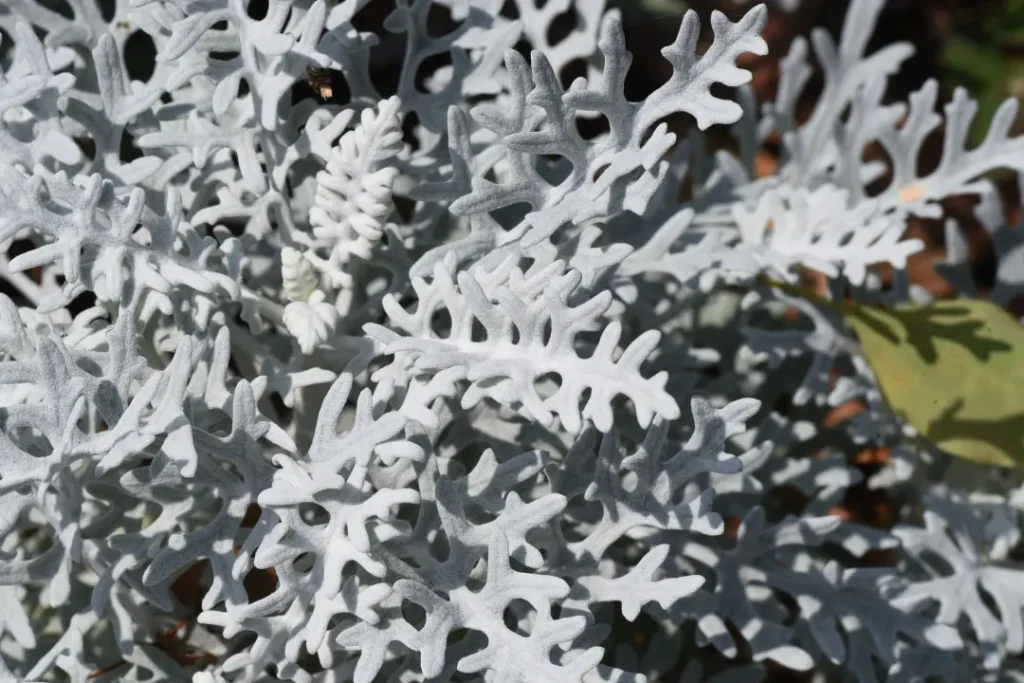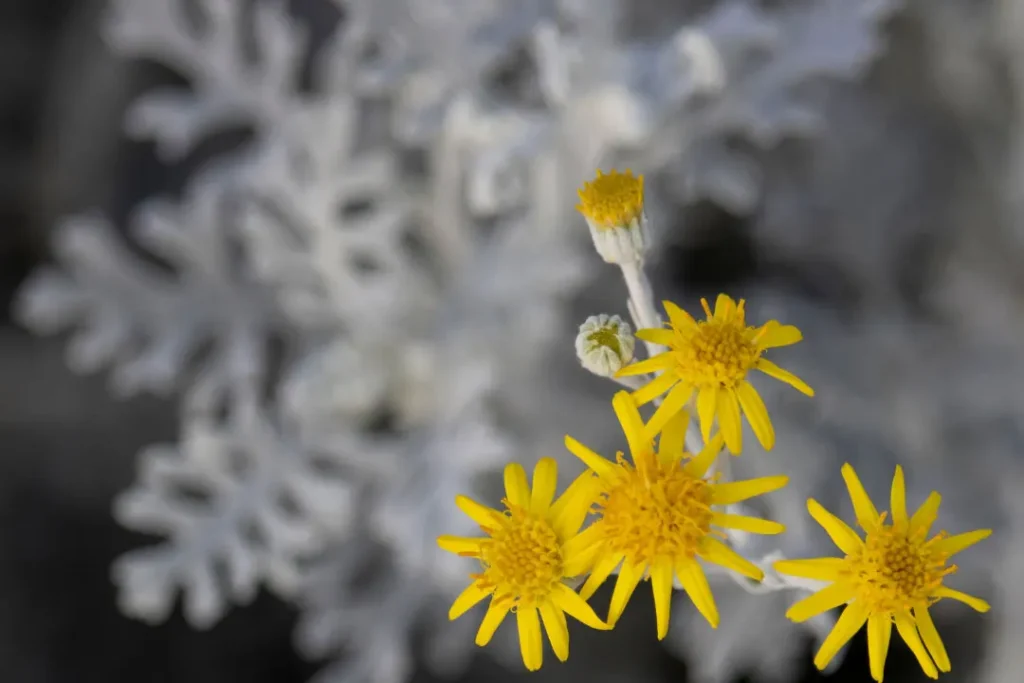Senecio cineraria is a perennial plant native to the Mediterranean area, valued for its decorative value due to its silver-grey leaf. Although it is frequently used in landscaping, new research is beginning to highlight its nutritional and medicinal benefits. This article offers a thorough analysis of dusty miller’s properties, including its advantages for health, recommended dose, side effects, possible drug interactions, and appropriate usage as a nutritional supplement.
You May Also Like:
5 Reasons You Should Know About the Vagus Nerve Gut Brain Connection
Chervil: Benefits, Dosage, Side Effects, Drug Interactions, and Other Important Information
Dusty Miller: Benefits, Dosage, Side Effects, Drug Interactions, and Other Important Information is an original (NootroPicsPlanet) article.
Nature of Dusty Miller
Dusty Miller is in the Asteraceae family, which is known for its hardiness, stunning silver leaves, and little yellow blooms. Senex, which means “old man” in Latin, is the origin of the plant’s scientific name, senecio cineraria, which alludes to its white-haired leaves.
Chemically, dusty miller has numerous bioactive substances that contribute to its nutritional and medicinal properties, like sesquiterpene lactones and flavonoids.
Health Benefits of Dusty Miller
Dusty Miller has many health benefits that have been recognized by conventional medicine. The plant’s sesquiterpene lactones and flavonoids have several anti-inflammatory, antioxidant, and antibacterial effects.
The anti-inflammatory qualities of dusty miller can be helpful for treating the symptoms of diseases like arthritis, which can cause inflammation. Its antioxidant properties help to lessen oxidative stress, which is a major factor in the emergence of chronic diseases like cancer and heart disease. Dusty miller’s antibacterial properties are useful in preventing bacterial and fungal diseases.

Chemistry of Dusty Miller
Dusty miller’s complex chemical makeup is at the core of its medicinal promise. There are many bioactive substances in this plant that are responsible for its medicinal properties. Sesquiterpene lactones like cinerarin are the most important. Numerous plants contain sesquiterpene lactones, which have a variety of therapeutic benefits, including anti-inflammatory and antibacterial properties.
Dusty miller is a major source of flavonoids, a broad class of phytonutrients recognized for their potent antioxidant action, in addition to sesquiterpene lactones. Since flavonoids have the ability to stop or delay the onset of many chronic illnesses, they have been the focus of most research.
The pyrrolizidine alkaloids, a class of naturally occurring poisons linked to liver damage and other health problems when ingested in large quantities, are also present in dusty miller. Sesquiterpene lactones and flavonoids in the plant contribute to its medicinal efficacy, but the presence of pyrrolizidine alkaloids also stresses the need for caution and more research surrounding its use.
Physiological Properties of Dusty Miller
Sesquiterpene lactones and flavonoids in dusty miller contribute to its health advantages through numerous physiological pathways.
Sesquiterpene lactones in dusty miller like cinerarin, are associated with its many anti-inflammatory effects. These substances prevent the synthesis of pro-inflammatory cytokines, which reduces inflammatory reactions in the body.
Sesquiterpene lactones in dusty miller also have antibacterial properties, making the plant potentially beneficial against bacteria and fungi . The ability of these chemicals to obstruct the development and reproduction of these microbes is the source of these antimicrobial properties.
Flavonoids in dusty miller have powerful antioxidant properties that help the body fight off dangerous free radicals. These substances defend against many chronic conditions connected to oxidative stress, including cardiovascular disease and some forms of cancer, by lowering oxidative stress and cellular damage.
Although dusty miller’s potential health advantages are encouraging, the plant’s pyrrolizidine alkaloids highlight the need for prudence and more research. Understanding the balance between advantageous and detrimental chemicals in dusty miller is essential for identifying its safe and effective usage as a dietary supplement since these compounds can cause liver damage when ingested in high amounts.

Optimal Dosage of Dusty Miller
The ideal dosage of dusty miller for medicinal purposes is still unknown, given the current amount of research that has been done on it so far. To identify the right dosage depends onyour specific health needs and circumstances. As with any medicinal plant or dietary supplement, it is advised to speak with your healthcare professional.
Side Effects
Despite dusty miller’s health advantages, you need to use it cautiously, as it can still have side effects. It contains pyrrolizidine alkaloids, which when ingested in excessive quantities can cause liver damage and other health issues.
Potential Substance Interactions
No specific drug interactions involving dusty miller have been currently documented. . However, if you are on medication or have certain medical problems, you are encouraged to speak with your healthcare provider before using it due to its biochemical profile.

Best Uses of Dusty Miller
Although dusty miller is typically utilized as a decorative plant, its bioactive components have a wide range of potential health and wellness applications. To conclusively confirm dusty miller’s medicinal efficacy and its ideal application in health and wellness regimens, additional scientific research is necessary. As with any herbal product, use must always be guided by knowledge, considering your specific health needs and conditions, potential health hazards, and advantages.
Dusty Miller: Conclusion
Dusty miller is an intriguing confluence of both decorative beauty and therapeutic efficacy. The plant’s distinctive bioactive profile offers fascinating possibilities for health and wellness, even if research on its therapeutic and medicinal use is still in its early phases. Future research must focus on the safe and appropriate usage of this underutilized plant as it continues to explore its possibilities. If you are interested in trying a natural supplement that supports antioxidant and antibacterial properties and can also add decoratove beauty to your surroundings, ask your doctor if dusty miller is right for you.
References:
- “Sesquiterpene lactones: Benefits to plants and people”. Retrieved from: https://www.ncbi.nlm.nih.gov/pmc/articles/PMC3694180/
- “Dietary flavonoids: Bioavailability, metabolic effects, and safety”. Retrieved from: https://academic.oup.com/ajcn/article/74/5/694/4737416
- Dusty Miller’s research while affiliated with University of Washington Seattle and other places.link:https://www.researchgate.net/scientific-contributions/A-Dusty-Miller-38852009
Important Note: The information contained in this article is for general informational purposes only, and should not be construed as health or medical advice, nor is it intended to diagnose, prevent, treat, or cure any disease or health condition. Before embarking on any diet, fitness regimen, or program of nutritional supplementation, it is advisable to consult your healthcare professional in order to determine its safety and probable efficacy in terms of your individual state of health.
Regarding Nutritional Supplements Or Other Non-Prescription Health Products: If any nutritional supplements or other non-prescription health products are mentioned in the foregoing article, any claims or statements made about them have not been evaluated by the U.S. Food and Drug Administration, and such nutritional supplements or other health products are not intended to diagnose, treat, cure, or prevent any disease.


